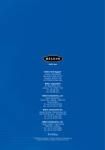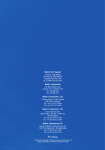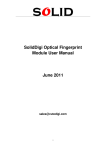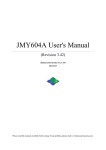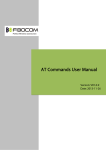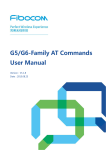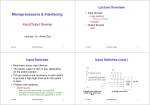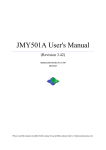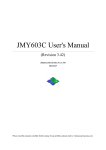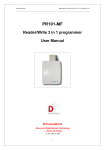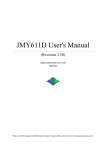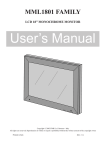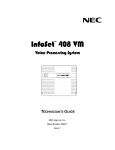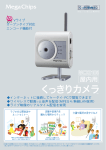Download LinkSprite RFID Reader/Writer Module (ISO14443
Transcript
LinkSprite RFID Reader/Writer Module (ISO14443 Proximity cards standard) HY502F User Manual December 2009 1 Brief Introduction HY502 series of RFID reader/writer modules are based on non-contact card reader ASCI chip compatible with ISO14443 standard. It uses 600nm CMOS EEPROM technology, supports ISO14443 typeA protocol, and also supports the MIFARE standard encryption algorithm. The chipset integrates analog modulation and demodulation circuits, only requires minimal peripheral circuits to function. The module supports UART interface, I2C interface, and SPI interface. The digital circuits has dual working voltages mode, TTL and CMOS. The HY502 module is targeting water, electricity, gas meters, vending machines, access control, elevators, drinking fountains, telephone billing system or other identification card reader system applications. Users can simply select the desired interfaces to harvest the full operation of the system and do not need to struggle with the complicated radio base station design. HY502 series supports Mifare One S50, S70, Ultra Light & Mifare Pro, FM11RF08 and other compatible cards. It can be set to automatically find cards, by default, to automatically find cards. HY502 series is a low-power modules, wide-voltage 2.7 ~ 5.5V, using an integrated module with embedded antenna can significantly reduce PCB size. Features o Supports three interfaces at the same time: o UART serial interface o SPI Interface o IIC interface o Automatically detect the card close to the antenna area, and generate an interrupt signal to the host MCU. o Employ chipset of ISO14434A standard, and support MIFARE standard encryption algorithm; o Working voltage is between 2.7V- 5.5V, has TTL/CMOS voltage modes. o Use industrial-grade high-performance processor, built-in hardware watchdog, with high reliability; o Anti-jamming processing and excellent EMC performance; o A few simple commands can cover the complicated underlying read and write card operations. 2 Pictures Size: 57.8mm X 34.5mm The embedded antenna can read cards within 0-6cm. The external antenna, which can be connected to J2 by disconnecting the 4 short soldering point, can read cards within 0-10cm. Pins Definition of pins: J1 is the connectors from module to host MCU, J2 is the connector for external antenna. 3 J1 connector: Pins Name J1-1 J1-2 J1-3 J1-4 J1-5 J1-6 J1-7 J1-8 J1-9 RXD/SCL TXD/SDA/MISO MOSI NSS RST M1 SIG VCC GND IO type (TTL/CMO S Voltage) I/O I/O I/O I I I O Power Ground Description UART receive or clock line for IIC and SPI UART send or data line for IIC, MISO for SPI MOSI for SPI Slave selection for SPI Reset, and active low. Floating is okay Interface selection bit 1 Interrupt signal, 0 means card is present Positive terminal of power Ground J2 connector: Pin J2-1 J2-2 J2-3 J2-4 J2-5 J2-6 Name GND TX1 GND TX2 GND RX Description Ground Sending antenna 1 Ground Sending antenna 2 Ground Receive antenna Electrical specification: Charater Parameter TSTR TOP Environment or storage temperature Operating temperature Vcc Operating voltages Icc1 TRST Operating current Minimum reset pulse duration • • Minimu m -40 -25 3 4.5 7 1.6 Typical +25 3.3* 5 54 Maximu m +150 +85 3.6 5.5 120 Unit o C C o V mA us In UART mode, the operating voltage is 5V. If want to work under 3.3V, please contact us at [email protected] If not specified, BOD is 2.7V. BOD is 4V if specifically work at 5V. 4 Selection of interface: HY502 supports UART, IIC and SPI at the same time. The selection of interface is one by setting the voltage level of NSS and M1. Pins M1 NSS Interface UART 11 IIC 10 SPI 01 The change of interface can be done when the module is in operation. But due to the interference, the process needs 4ms. To guarantee the reliability, we recommend to add a delay of 20ms. Definition of interface pins at different mode: Pin Mode IIC SPI UART J1-1 RXD/SCL SCL SCL RXD J1-2 TXD/SDA/MISO SDA MISO TXD J1-3 MOSI A0 MOSI X J1-4 NSS 0 1 1 J1-5 M1 1 0 1 Note: 0 means low voltage, 1 means high voltage, x means “don’t care”. UART interface The default baud rate is 19200bps. Power on default is automatically scan for card, and don’t need the host to frequently issue scan for card command. When card is present, SIG will send an interrupt signal, and then host MCU can use scan for card command to read the serial number of the card. The following two diagrams show how HY502 is connected to host MCU and PC. A RS232 level shifter is needed when connecting to PC. The RST signal can be left floating, and will automatically reset on power cycle. 5 Connection between MCU and HY502. Connection between PC and HY502 using a RS232 or RS485 signal level shifter. IIC interface • • • • • Only require 2 wire 7 bit programmable address, and can support up to 127 module Data rate can be as high as 400kHz. Noise suppression circuit can support glitch with duration shorter than 50ns. Internal pull-up resistors Connection between MCU and HY502. 6 R1 and R2 are pull-up resistors. The normal value is 10k. The driving capability is 400pF without additional driver. IIC timing diagram: The bus timing diagram is shown below. The SDA must be kept stable logical signal when SCL is high. Logical high is data 1 and logical low is data 0. The data can only be changed when the SCL is logical low. SPI interface • • • • 3-wire synchronous data transfer Write jam protection Wake up call from bus Master and salve 7 NSS is the slave selection signal, and active low. SPI timing diagram: Driver example #include "main.h" #include "hy502.h" #define KEY_PRESS 0 sbit M1 =P1^3; // mode define #define UMODE 0 // uart mode #define IMODE 1 // iic mode #define SMODE 2 // spi mode // mode select funtion void modset(unsigned char xx) 8 { if(xx==0) //uart { M1=1; NSS=1; } else if(xx==1) //iic { M1=1; NSS=0; } else if(xx==2) //SPI { M1=0; NSS=1; } } /************************** main function start here *******************************/ void main() { uchar idata cStatus; uchar BusMode; InitializeSystem(); // Init Reset_HY502(); // LED_YELLOW=0; //test led LED_GREEN=0; delay_10ms(50); // LED_YELLOW=1; LED_GREEN=1; //LED light 0.5s beep(2); //test buzz //----- test key------// if(KEY1==KEY_PRESS) splash(1); if(KEY2==KEY_PRESS) splash(2); if(KEY3==KEY_PRESS) splash(3); if(KEY4==KEY_PRESS) splash(4); if(KEY1==KEY_PRESS) { BusMode=UMODE; // Select UART } else if(KEY2==KEY_PRESS) { BusMode=IMODE ; // Select IIC { a0=1; a1=0; a2=1; } } else if(KEY3==KEY_PRESS) { BusMode=SMODE ; // Select SPI } modset(BusMode); // Set interface mode 9 delay_10ms(50); //-----------------main loop ---------------// while (1) { // KeyPress(); process key // add your code here //check command tag if (g_bReceCommandOk) { g_bReceCommandOk = FALSE; if(BusMode==IMODE) { cStatus=cmd_process_iic(); if(cStatus) { cStatus=0; } } else if(BusMode==SMODE) { cStatus=cmd_process_spi(); if(cStatus) { cStatus=0; } } else { // cStatus=cmd_process_uart(); if(cStatus) { cStatus=0; UartSend(g_cReceBuf); // Send data to uart. // add your code here } } Interface Communication Protocols 1. UART protocol • • 1 start bit + 8 data bit + 1 stop bit Baud rate: 19200 10 • • • • • • • Command format: o Command header + length byte + command byte + data field + check byte Command header: 0XAA 0xBB, if the following data contains 0xAA, please add an additional 0x00 to distinguish the command header, but the length byte will not be increased. Length byte: the byte length from length byte to last byte of data field. Command byte: command code Data field: the data for the command code Check byte: the accumulated XOR byte value from the length byte to last byte of data field. Return data format: o Success: Command header + length byte + command byte + data field + check byte o Failed: :Command header + length byte + inverted command byte + data field + check byte 2. IIC protocol • • • • • • • • The 4MSB of the IIC address is 1010, ie, 0xA0, the four LSB of IIC address can be set set using A2A1A0+W/R. Data rate of IIC communication: 400kbps Data format: (Address+W/R) + length byte + command byte + data field + check byte o Example, the module address is 0xA0, Write command, W/R=0, so the write command will be: 0xA0 +0x0 = 0xA00 o Example, the module address is 0xA0, Read command, W/R=1, so the read command will be: 0xA0+0x1= 0xA1 Length byte: the length from length byte to the last byte of data field Command byte: the command code Data field: the data for the command code Check byte: the accumulated XOR byte value from the length byte to last byte of data field. Return data format: o Success: Command header + length byte + command byte + data field + check byte o Failed: Command header + length byte + inverted command byte + data field + check byte 3. SPI protocol • Data format: Status byte + length byte + command byte + data field + check byte 11 • • • • • • Status byte: the status byte of the bus. A status byte will be sent in the beginning of sending operation. Length byte: the length from length byte to the last byte of data field Command byte: the command code Data field: the data for the command code Check byte: the accumulated XOR byte value from the length byte to last byte of data field. Return data format: o Success: Command header + length byte + command byte + data field + check byte o Failed: Command header + length byte + inverted command byte + data field + check byte Command table and return value (UART is used as example, IIC and SPI will not include the command header 0xAA 0xBB) Note: Unless specified, all numbers are hex. ID Command Name Module Control 1 Status Send Return Send: Example Length Byte 0x03 0x02 aabb Command header Return: Set card IDLE 2 Example 0x02 Success 0x02 Return Fail 0x02 Return Send: aabb Command header Return: Set automatic Send 0x11 1 byte control byte, software power dropping mode, nonzero will exit soft power dropping mode, and 0x00 will enter soft power dropping mode 0x11 03 length byte 0x03 11 00 12 command code data field check byte 02 length byte 11 command code 0x12 13 check byte When this command is executed, the card will be set to be idle. For reactivation, card needs to be removed from antenna area, and move back. 0x12 0xED 02 length byte aabb Command header 3 Data and Description aabb Command header Send Command Code 02 length byte 12 10 command code check byte 12 command code 0x13 12 10 check byte 1 byte data field, 0x01 to turn on automatic scan, and 0x00 to turn off scan Example Success 0x02 Return Fail 0x02 Return Send: aabb Command header Return: 4 Example 02 Command header Return: Example Send Read block 6 Example Send 7 Example Return: 8 Wallet Initializatio n 19 check byte This function includes scan card, anticollision, and select the card 0x20 4 byte data: the serial number of the card 02 20 22 command code check byte 06 length byte 0x0A 20 command code 92BF7259 data field 20 check byte 0x21 1 byte key tag+ 1 byte block number + 6 byte key Key tag: 0x00 – PICC_AYTHENT1A 0x01 – PICC_AUTHENT1B 0x21 16 byte data 0xDE 0a length byte aabb 21 length byte 00 08 ffffffffffff 23 command code 12 0x1A data 21 command code check byte 00112233445566778899AA00BBCCDDEEFF data field 33 check byte 1 byte key tag+ 1 byte block number + 6 byte key Key tag: 0x00 – PICC_AYTHENT1A 0x01 – PICC_AUTHENT1B 0x22 0x22 0xDD 1a 22 length byte command code aabb Command header 04 00 data field 0x20 aabb Command header 19 command code length byte Success 0x02 Return Fail 0x02 Return Send: aabb 1b 0xDF Success 0x12 Return Fail 0x02 Return Send: aabb Return: 19 command code check byte 04 0x02 Command header Write block 02 length byte Command header 11 check byte 0xe6 aabb Command header 10 No data field 2 byte data field, card type S50 card: 0x0400, S70: 0x0200. 0x19 length byte Command header 00 13 command code 0x19 Success 0x06 Return Fail 0x02 Return Send: aabb Return: 13 command code data field check byte length byte Send 0x02 Success 0x04 Return Fail 0x02 Return Send: aabb Send 5 03 aabb Command header Scan for card 0xEC length byte Command header Read card type 0x13 02 length byte 00 08 ffffffffffff 22 command code Send 0x0E 0x23 Success 0x02 0x23 13 00112233445566778899AA00BBCCDDEEFF data 30 check byte 20 check byte 1 byte key tag+ 1 byte block number + 6 byte key + 4 bytes init wallet amount Return Fail Return Send: Example 0x02 aabb Send 9 Example 0x0A Command header Send Deposit money 10 Example Withdraw money 11 Example 24 0x0E 27 11110000 data 24 command code check byte 11110000 data 22 check byte 1 byte key tag+ 1 byte block number + 6 byte key+ 4 bytes wallet amount (LSB in the front) 0x25 0x25 0xDA 0e 25 length byte aabb command code 02 0x0E Command header 00 09 ffffffffffff command code 06 length byte 25 length byte command code 00 08 ffffffffffff 11110000 data 22 check byte 27 check byte 1 byte key tag+ 1 byte block number + 6 byte key+ 4 bytes wallet amount (LSB in the front) 0x26 Success 0x02 Return Fail 0x02 Return Send: aabb Return: 4 bytes wallet amount (LSB in the front) 0a Command header Send 0x24 0xDB Success 0x02 Return Fail 0x02 Return Send: aabb Return: 21 check byte 1 byte key tag+ 1 byte block number + 6 byte key length byte Command header check byte 23 command code 24 11110000 data 0x24 aabb Command header 00 08 ffffffffffff command code 02 length byte Success 0x06 Return Fail 0x02 Return Send: aabb Return: 23 length byte aabb Command header Read wallet 0e Command header Return: 0xDC 0x26 0xD9 0e 26 length byte aabb Command header command code 02 length byte 14 26 command code 00 08 ffffffffffff 11110000 data 24 check byte 21 check byte LinkSprite Technologies, Inc. Add:1410 Cannon Mountain Dr, Longmont, CO 80503 Tel: 720-204-8599 Email:[email protected] Technical questions: [email protected] Web:www.linksprite.com 15

















